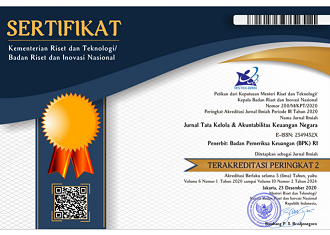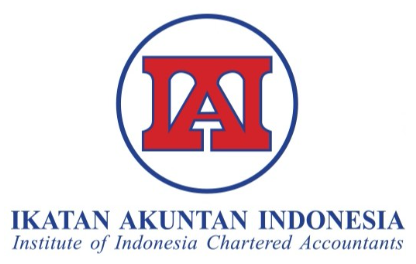ASUMSI KEGIATAN STRATEGIS UNTUK ROADMAP TRANSFORMASI BADAN PEMERIKSA KEUANGAN REPUBLIK INDONESIA
DOI:
https://doi.org/10.28986/jtaken.v4i1.155Keywords:
kegiatan strategis, roadmap transformasi, BPK RI, strategic assumption surfacing and testingAbstract
Penelitian ini melanjutkan penelitian sebelumnya yaitu “Model Transformasi BPK RI: Menggunakan Metode Interpretive Structural Modeling†(Pramono & Hendharto, 2017), yang menghasilÂkan 13 kelompok aktivitas yang paling dibutuhkan dalam transformasi BPK RI. Penelitian ini akan mengelaborasi setiap kelompok aktivitas dari 13 kelompok aktivitas tersebut menjadi beberapa asumsi kegiatan strategis. Penelitian ini bertujuan untuk mendapatkan berbagai asumsi kegiatan strategis yang akan diprioritaskan dalam roadmap transformasi BPK RI dengan menggunakan metode Strategic Assumption Surfacing and Testing (SAST). Data diperoleh melalui dua kali FGD dengan peserta pegawai BPK RI yang terpilih berdasarkan latar belakang pendidikan dan tingÂkat jabatan. Hasil penelitian ini menyimpulkan bahwa elaborasi terhadap 13 kelompok aktivitas transformasi BPK RI menghasilkan 114 asumsi kegiatan strategis transformasi BPK RI. RincianÂnya yaitu kuadran I (penting dan pasti) terdapat 55 asumsi kegiatan strategis, kuadran II (penting dan tidak pasti) terdapat 58 asumsi kegiatan strategis, kuadran III (tidak penting dan tidak pasti) tidak terdapat asumsi kegiatan strategis, dan kuadran IV (tidak penting dan pasti) terdapat satu asumsi kegiatan strategis. Selanjutnya 55 asumsi kegiatan strategis yang termasuk ke dalam kuadran I akan menjadi kegiatan dalam roadmap transformasi BPK RI.
References
Bavik, A. (2016). Developing a new hospitality industry culture scale. International Journal of Hospitality Management, 58, 44-55.
Behl, A. & Singh, M. (2014). Critical analysis of management information system of selected Indian microfinance institutions. Procedia - Social and Behavioral Sciences, 133, 20-27.
BPK. (2015). Peraturan BPK Nomor 7/K/I-XIII.2/12/2015 tentang Rencana Strategis BPK RI tahun 2016-2020. Jakarta: BPK.
BPK. (2016). Roadmap Reformasi Birokrasi BPK RI tahun 2016-2020. Jakarta: BPK.
BPK. (2017). Peraturan BPK RI Nomor 1 tahun 2017 tentang Standar Pemeriksaan Keuangan Negara. Jakarta: BPK.
Brzezinski, S. & Bak, A. (2015). Management of employees commitment in the process of organization transformation. Procedia Economics and Finance, 27, 109-115.
Cahyono, B. (2000). Proactive environmental management: strategi untuk mencapai keunggulan dalam persaingan internasional. Manajemen Usahawan Indonesia, 09.
Choi, J. M. (2017). Factors influencing public officials responses to requests for information disclosure. Government Information Quarterly, 35 (1).
Churchman, C.W. (1971). The Design of Inquiring Systems. New York: Basic Books.
Collings, D. G., & Mellahi, K. (2009). Strategic talent mangement: a review and research agenda. Human Resource Management Review, 19, 304-313.
Daniela, P. & Attila, T. (2013). Internal audit versus internal control and coaching. Procedia Economics and Finance, 6, 694-702.
Easton, A.C. (1988). An experimental investigation of automated versus manual support for stakeholder identification and assumption surfacing in small groups. (Disertasi University of Arizona, 1988).
Fombrun, C. J. (1996). Reputation: Realizing Value from the Corporate Image. Boston: Harvard Business School Press.
Fritz, M.M.C., dkk. (2018). A supply chain perspective of stakeholder identification as a tool for responsible policy and decision making. Environmental Science and Policy, 81, 63-76.
Durham, M. G. & Kellner, D. M. (2006). Media and Cultural Studies. Massachusetts: Blackwell.
Herbig, P., dkk. (1994). A model of reputation building and destruction. Journal of Business Research, 31, 23-31.
Jefkins, F. (2003). Public Relations. Jakarta: Penerbit Erlangga.
Malhotra, N., & Hinings, C. R. (Bob) (2015). Unpacking continuity and change as a process of organizational transformation. Long Range Planning,48 (1), 1-22. DOI: 10.1016/j.lrp.2013.08.012
Martinelli, D., & Erzikova, E. (2017). Public Relations Leadership Development Cycle: A Cross-Cultural Perspective. Public Relations Review.
Mason, R.O., & Mitroff, I. (1981). Challenging Strategic Planning Assumptions. New York: John Wiley.
Mathis, R. L., & Jackson, J. H. (2001). Human Resources Management. Jakarta: Salemba Empat.
Mendonca, V., dkk. (2015). Cooperation network in the tourism sector: multiplication of business opportunities. Procedia Computer Science, 64, 1172-1181.
Mitroff, I., & Emshoff, J.R. (1979). On strategic assumption-making: a dialectical approach to policy and planning. The Academy of Management Review, 4 (1), 1-12.
Pamudji, S. (1985). Kerjasama Antar Daerah Dalam Rangka Pembinaan Wilayah: Suatu Tinjauan dari Segi Administrasi Negara. Jakarta: Bina Aksara.
Peraturan Presiden Nomor 76 Tahun 2013 tentang Pengelolaan Pengaduan Pelayanan Publik.
Philip, G. & McKeown, I. (2004). Business transformation and organizational culture: the role of competency, is and tqm. European Management Journal , 22 (6), 624-636.
Polonsky, M.J. (1995). A stakeholder theory approach to designing environmental marketing strategy. Journal of Business and Industrial Marketing, 10 (3), 29-46.
Prahono, A., & Elidjen. (2017). Evaluating the implementation of public information disclosure on the official website of indonesian ministries. Procedia Computer Science, 116, 54-60.
Pramono, A. J. (2016). Analisis faktor-faktor yang memengaruhi transformasi kapabilitas organisasi dan peran BPK RI: menggunakan metode analytic network process. Jurnal Tata Kelola dan Akuntabilitas Keuangan Negara, 2(2).
Pramono, A. J., & Hendharto, H. (2017). Model transformasi Badan Pemeriksa Keuangan Republik Indonesia: menggunakan metode interpretive structuring modeling. Jurnal Tata Kelola dan Akuntabilitas Keuangan Negara, 3 (2), 91-111.
Rauffet, P., dkk. (2012). Conceptual model and it system for organizational capability management. Computers in Industry, 63, 706-722.
Reddy, C. M., & Srinivasan, V. (2015). Dialogue on leadership development. IIMB Management Review, 27 (1), 44-55.
Riswandi. (2009). Ilmu Komunikasi. Jakarta: Graha Ilmu.
Roben. (2008). Manusia Komunikasi, Komunikasi Manusia. Jakarta: Kompas Media Nusantara.
Sawyer, L. B., dkk. (2005). Sawyer’s internal auditing: the practice of modern internal auditing. Florida: The Institute of Internal Auditors Inc.
Sinambela, L. P. (2008). Reformasi Pelayanan Publik Teori, Kebijakan, dan Implementasi. Jakarta: Bumi Aksara.
Undang-Undang Nomor 14 Tahun 2008 tentang Keterbukaan Informasi Publik.
Velayutham, S. (2003). The accounting professions code of ethics: is it a code of ethics or a code of quality assurance. Critical Perspectives on Accounting, 14, 483-503.
Warick, D.D. (2017). What leaders need to know about organization culture. Business Horizons, 1370, 10.
Wursanto. (2005). Dasar-Dasar Ilmu Organisasi. Yogyakarta: Andi Offset.
Wu, K. J., dkk. (2015). Exploring eco-innovation in dynamic organization capability under incomplete information in the Taiwanese lighting industry. International Journal of Production Economics, 181 (B), 419-440.
Zeid, A. (2014). Business transformation: a roadmap for maximazing organizational insights. New Jersey: John Wiley and Son Inc.
Downloads
Submitted
Accepted
Published
How to Cite
Issue
Section
License

Jurnal Tata Kelola dan Akuntabilitas Keuangan Negara is licensed under
a Creative Commons Attribution-ShareAlike 4.0 International License





















